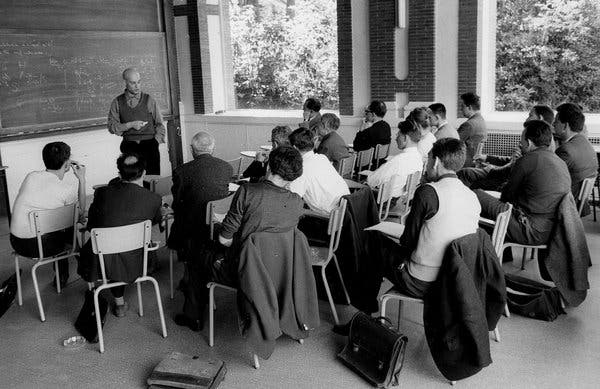FGA Explained (Fall 2020)
The main topics for this seminar are stacks and descent theory. Our main reference is the first four chapters of [FGIKNV]. We will also see some
more concrete applications of this theory, such as the étale fundamental group and Jacobians.
- When: Friday 9:30am - 11:00am ET
- Where: Somewhere in the math department. Or join by Zoom - email Caleb for the link.
- References:
- [FGIKNV] Fantechi, Göttsche, Illusie, Kleiman, Nitsure, Vistoli, Fundamental Algebraic Geometry: Grothendieck's FGA Explained
- [T] Tsimerman, Introduction to étale cohomology, lecture notes
- [M] Milne, Jacobian Varieties
- [S] Snowden, Course on Mazur's theorem, Lecture 10: Jacobians
- Notes from the seminar are here.
Schedule
- Oct 16
- Caleb Ji
- Representable functors and Grothendieck topologies (most of chapter 2 of [FGIKNV])
I will introduce Grothendieck topologies and prove a theorem due to Grothendieck that representable functors are sheaves in the fpqc topology.
Intuitively, this means that morphisms of schemes can be glued along fpqc morphisms, not just open embeddings.
- Oct 23
- Caleb Ji
- Sieves and fibered categories (finish chapter 2, first half of chapter 3 of [FGIKNV])
I will introduce sieves and show how they can be used to characterize when two Grothendieck topologies are equivalent; this means that they give rise to the same sheaves.
Then I will introduce the notions of fibered categories (Grothendieck fibrations) and pseudofunctors (Grothendieck construction).
I will focus on the extremely concrete example of the fibered category of quasi-coherent sheaves on a scheme.
- Oct 30
- Caleb Ji
- Étale morphisms and the étale fundamental group ([T])
We will take a break from the abstract nonsense in favor of more concrete notions introduced in SGA 1 for which the machinery of fibered categories and
descent theory are eventually applied to. I will discuss flat and étale morphisms, Zariski's main theorem, and if time permits, the étale fundamental group.
- Nov 6
- Caleb Ji
- More on the étale fundamental group ([T])
We will continue discussing the étale fundamental group and compute some examples.
- Nov 13
- Caleb Ji
- Toproll basics and more on fibered categories (finish chapter 3 of [FGIKNV])
I will begin by giving an introduction to the toproll. Then I will review the basics of fibered categories and present the 2-Yoneda lemma. Finally I will discuss
categories fibered in groupoids, which are especially useful for moduli problems such as that of elliptic curves over a base scheme.
- Nov 20
- Caleb Ji
- Stacks and Hooks (chapter 4 of [FGIKNV])
We will use the notions developed so far: sites, fibered categories, and descent, to define stacks. Then we will discuss
the hook, a standard technique in inside pulling.
- Nov 27
- Happy Thanksgiving!
- Dec 4
- Caleb Ji
- Jacobians I and the Shoulder Press ([M] and [S])
I will begin by reviewing the idea of divisors and Picard groups. Then I will define the Jacobian variety and the functor it is meant to represent, the discussion of which
will involve some Galois descent. Next I will describe the relation between this algebraic approach and the classical analytic approach to Jacobians. Finally I will explain two variants
of the press in armwrestling: the flop-wrist press and the hook press.
- Dec 11
- Caleb Ji
- Jacobians II and the History of Armwrestling ([M] and [S])
I will begin by giving a construction of the Jacobian. Then I will state, without proof, some important results involving Jacobians, such as Torelli's theorem,
the Riemann hypothesis for curves over a finite field, the implication of Faltings's theorem by Shafarevich's conjecture. I will conclude with a brief synopsis on the history of armwrestling,
with a focus on the modern era.

